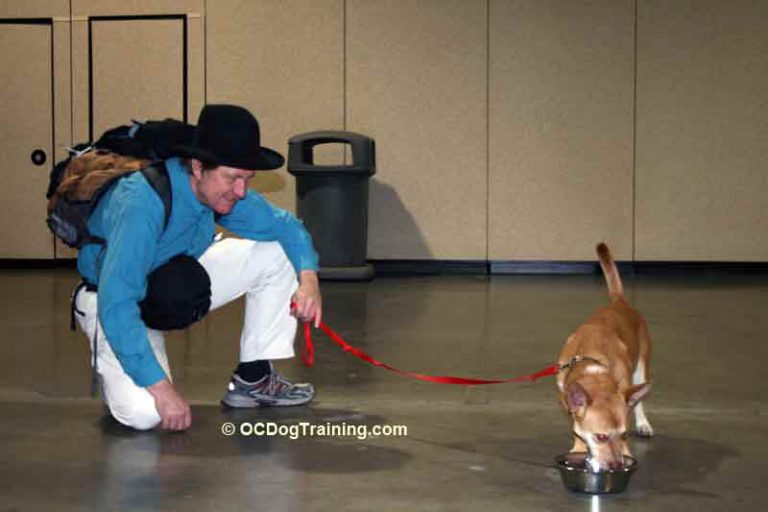Some Questions About Interactive Dog Toys and Puzzles
By your dog trainer Andrew Ledford 714-827-4058
Interactive Dog toys with special interest placed on dog puzzle toys, what is their effect on dog training, learning, and teaching – thoughts from a Dog Trainers Forum presentation.
This article was first published around 2008 on my 101-Dog-Training-Tip website concerning a dog training presentation I attended about interactive dog toys. The first version of the article is in black, I then added new thoughts a couple weeks later in red. Then after met a man who was color blind I decided to use a yellow highlight instead. The the yellow highlighted comments provide possible answers to some of the questions of the original dog toy / training article. –
This Interactive Dog toys article is about an interesting Dog Trainers Forum meeting that I regularly attend. The subject of this particular meeting was dog toys. From what I understand play and learning are in some way related. We have much to learn about our own behavior and our dogs by better understanding play.
My current thought is no doubt influenced somewhat by what I happen to be reading at any given time. I find that the relevancy of a recent history of my reading Verbal Behavior tends to influences my thought and current behavior. I know others may follow a different line of thought, most notably Chomsky. I too find Chomsky interesting and his arguments against B.F. Skinner do have some merit, however as you read you’ll find that I am afflicted by a serious human condition that like a magnet pulls me toward Skinner.
I am once again rereading many of B.F. Skinner’s books that over twenty-five years ago had such a big influenced on my life and my style of dog training. While at times I may illustrate some of Skinners shortcomings, I am quite the Skinner fan. Mona can you forgive my Skinner behaviorism? It looks like even I am plagued by at least one of those cantankerous isms. You must understand that occasionally I’m also influence by the African god Edshu, so please excuse my dichotic stance on issues of behavior. Don’t be surprised if at a meeting you see me with an Edshu inspired hat. I think that some of the follies of humanity that Edshu illuminated Francis Bacon also specified. And I know how much most of my dog training colleagues are enamored with the scientific method.
Some may think my opinions trivial, and that they may be, or perhaps they are just not understood.
Interactive dog games and dog puzzle games, some questions
First let me say I loved the interactive dog games and the insight they provide. I find them fascinating. I also thought the presentation was nicely done. I am so glad the presenter gave and explained the background information and her experience with the interactive dog puzzle games. Quite thought provoking. As a result of this dog toy presentation I am now going to include interactive dog games into at least one my new programs. Specifically some type of interactive puzzle toy will be used in a future dog program.
Since I am rereading several books by who many would call the father of behaviorism, I have some questions about Monday’s meeting. I would not even ask except it is my belief that so many group members are positive reinforcement dog trainers and/or ultra humane towards animals oriented. After all, were we not meeting at the Humane Society?
Is it good to cause frustration? Does this promote learning? Or in the case of the more interesting interactive toys, is it simply for human entertainment? I understand about letting a dog work out a problem, but does this mean the problem is too difficult or that it could have been done in a more efficient way? I have to admit I use extinction quite a lot but usually I have a specific purpose when implementing this technique and it is often done in a way that gets a predefined and well planned response. While I find extinction and shaping entertaining, I doubt if those I am teaching do.
Probably it is a good practice to let the dog work out the problem once we have taught the way we prefer the task be preformed. It may be good to let the animal work the problem out up to the point right before extinction. We can create these conditions in training programs so that they are planned for and under our control. In the process we can also teach efficient methods of problem solving so our subject responds in a predictable and effective way.
If we want dogs to learn how to work through frustration (extinction), should this not be taught as a separate behavior? Or is this the purpose of games? If so, for pet dogs this brings up a whole new set of questions.
I do think games can be designed to teach working though frustration. This is an interesting area to investigate.
One of the questions is, what is learned? What is reinforced? Are we simply rewarding persistence, or variation, or is something else being rewarded too. Is the behavior being rewarded something that we will find objectionable in the future.
I find the question of what is being reinforced of some importance for pet dogs. I do not think we should reward problem solving in a pet dog that leads to problems for people. It would be best to teach some preliminary games that teach a preferred method of response on the dog’s part. By having a past history of responding in a desirable fashion the dog will more readily use previously reinforced tactics to sole novel problems. If the dog does not use the desired behavior we can intervene and teach it to.
It was suggested that the value of doing puzzle exercises is that the owners enjoy it and anything that increases owner dog interaction is worth it. Now we come to what could be a key point of my questioning and of efficient learning. Is an extra low stress method of teaching efficient responses, “No fun?” This is more than a rhetorical question, if extra low stress is “No fun” it brings up important points that need to be addressed. At least by me. Is highly efficient teaching aversive to the teacher? Is it aversive to the learner? Does extra low stress learning equal boring? If so, boring for who?
Probably we experience the aversive state of being bored when behavior is under aversive control. This would make sense with dog training. Most of the people who hire a dog trainer are doing it because of negative reinforcement. They are under aversive control to escape some undesirable condition the dog is creating. There is the positive reinforcement of owning a dog such as the emotions of love, and the aversive behavior of an untrained dog. People want to continue receiving the positive reinforcement associated with the unconditional love a dog provides while getting rid of the aversive consequences of undesirable behavior.
I suspect there needs to exist some out of the ordinary conditions before extra efficient teaching and learning techniques are reinforcing. Is it necessary for unorthodox condition to exist before unorthodox learning will be sought? If well programmed learning is boring then extraordinary conditions will probably need to exist for at least one of the critical participants in the learning matrix before extraordinary teaching becomes attractive. I am trying to determine what the lower limits of those conditions are. When and/or where is it that people will readily engage in extra easy learning and teaching? Not only for dog training but for other endeavors as well.
I don’t have a good answer for this. But I have noticed that once the owner is no longer under the aversive control of undesirable dog behavior they quit working their dogs as much as they should. Usually dog owners are relieved of the most aversive qualities of a dog’s behavior before the dog is completely conditioned to behave as desired. When the behavior reappears they think the dog is untrainable. In reality it’s the owner’s behavior that was not maintained at a high enough rate of responding to ensure the proper conditioning of the dog’s behavior.
If training can be brought under the control of positive reinforcement, owners will not be bored with training and they will enjoy training their dogs. Making dog training into a positive reinforcer is easier said than done. Dog training not only has a monetary cost but more importantly, it has a cost in time and effort. Working with a trainer can reduce the effort and time needed for training, but it can’t completely eliminate it. Trainers can even attempt to make training rewarding in itself. However for the majority of dog owners their behavior is under aversive control.
Overcoming inertia in itself is slightly aversive. How much more so is making time in an otherwise over scheduled time poor day, for dog training. Getting started, Taking time from other activities, and putting forth effort are all somewhat aversive in themselves. To overcome the aversive nature of making time for training the act of training must have some rather powerful reinforcing consequences. When training becomes playful, some of the aversive nature of making time to train will be eliminated. When training becomes playful then we look forward to time when we can enjoy the opportunity to teach our dogs and learn something at the same time. The behavior may be the same but the emotions are different. The first are emotions elicited by behavior under aversive control and the second are the emotions elicited by behavior under the control of positive reinforcement. If one of our goals is to be happy and to have happy canine children then we should try to develop as many positive contingencies in our lives as possible. This should be done simultaneously while developing the mental fortitude to work through hardship and aversive control.
Dog training is a well integrated combination of mechanical techniques influenced by those mysterious spirits we call emotions. I realize that behaviorist dislike acknowledging emotions except in the most basic way. While Skinner equated all behavior to problem solving, it is problem solving done in a turbulent river of churning emotions. Even Skinner succumbed to the power of emotion. Perhaps he could have avoided this had he paid more attention to the antics of Edshu.
Play has become of special interest to me. I am thinking more and more about play based on Konrad Lorenz thoughts on humor. I think Lorenz’s use of humor for transcending aggression in humans is unlikely to work, but play may fulfill that role. An interesting component to play is it often involves learning that includes intrinsic reinforcement. Which brings us right back to Skinner and learning theory. As many of you know I am now much more pet dog oriented as opposed to working dog oriented. If you have read my book you will know I think pet dogs are working dogs. They are a very special kind of working dog that’s not well acknowledged. They also have special needs and traits just as the more well known types of working dogs do. The tricks of pet dog training are probably just as idiosyncratic as those of other specialist working dogs and perhaps in the long run more important.
For many, learning itself is playful. This Skinner attributes to a fortunate early schedule of positive reinforcement. Can we arrange these schedules in an ethical manner for both dogs and people?
If you have any comments or questions you can comment on one of my social l media accounts. My Twiitter is twitter.com/AndrewLedford
Wishing all of you the best in dog training and in life
Andrew Ledford
714-827-4058


